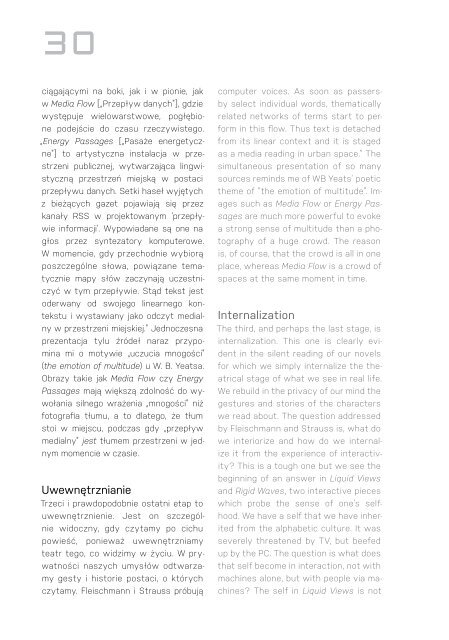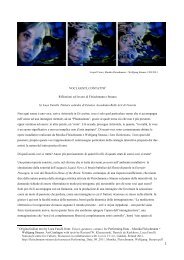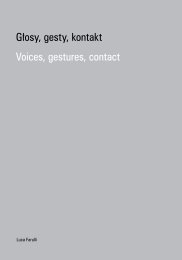Performing Data | Monika Fleischmann + Wolfgang Strauss
Performing Data is a review of Monika Fleischmann´s and Wolfgang Strauss´artistic body of work and a catalogue of their exhibition in Poland 2011. It presents works from Virtual Reality (Home of the Brain) up to Mixed Reality (Murmuring Fields) from Fluid Interface (Liquid Views) up to Floating Interface (Medienfluss) and texts by Ryszard W. Kluszczynski, Derrick de Kerkhove, Luca Farulli. Monika Fleischmann and Wolfgang Strauss from the German Fraunhofer research institute show us an intersection of the body and immaterial digital data. Immersion in data flow causes productive moments of disturbance and suspension, and consequently – a feeling of real physical presence. Fleischmann, Monika; Strauss, Wolfgang: Performing Data | Performowanie danych. National Centre for Culture, Warszawa 2011 in collaboration with Laznia CCArt, Gdańsk, Poland 2011 ISBN 978-83-61587-55-2 (en/pl) http://artline-southbaltic.eu/de/event/performing-data/
Performing Data is a review of Monika Fleischmann´s and Wolfgang Strauss´artistic body of work and a catalogue of their exhibition in Poland 2011. It presents works from Virtual Reality (Home of the Brain) up to Mixed Reality (Murmuring Fields) from Fluid Interface (Liquid Views) up to Floating Interface (Medienfluss) and texts by Ryszard W. Kluszczynski, Derrick de Kerkhove, Luca Farulli.
Monika Fleischmann and Wolfgang Strauss from the German Fraunhofer research institute show us an intersection of the body and immaterial digital data. Immersion in data flow causes productive moments of disturbance and suspension, and consequently – a feeling of real physical presence.
Fleischmann, Monika; Strauss, Wolfgang: Performing Data | Performowanie danych. National Centre for Culture, Warszawa 2011 in collaboration with Laznia CCArt, Gdańsk, Poland 2011 ISBN 978-83-61587-55-2 (en/pl) http://artline-southbaltic.eu/de/event/performing-data/
You also want an ePaper? Increase the reach of your titles
YUMPU automatically turns print PDFs into web optimized ePapers that Google loves.
ciągającymi na boki, jak i w pionie, jak<br />
w Media Flow [„Przepływ danych”], gdzie<br />
występuje wielowarstwowe, pogłębione<br />
podejście do czasu rzeczywistego.<br />
„Energy Passages [„Pasaże energetyczne”]<br />
to artystyczna instalacja w przestrzeni<br />
publicznej, wytwarzająca lingwistyczną<br />
przestrzeń miejską w postaci<br />
przepływu danych. Setki haseł wyjętych<br />
z bieżących gazet pojawiają się przez<br />
kanały RSS w projektowanym ‘przepływie<br />
informacji‘. Wypowiadane są one na<br />
głos przez syntezatory komputerowe.<br />
W momencie, gdy przechodnie wybiorą<br />
poszczególne słowa, powiązane tematycznie<br />
mapy słów zaczynają uczestniczyć<br />
w tym przepływie. Stąd tekst jest<br />
oderwany od swojego linearnego kontekstu<br />
i wystawiany jako odczyt medialny<br />
w przestrzeni miejskiej.” Jednoczesna<br />
prezentacja tylu źródeł naraz przypomina<br />
mi o motywie „uczucia mnogości”<br />
(the emotion of multitude) u W. B. Yeatsa.<br />
Obrazy takie jak Media Flow czy Energy<br />
Passages mają większą zdolność do wywołania<br />
silnego wrażenia „mnogości” niż<br />
fotografia tłumu, a to dlatego, że tłum<br />
stoi w miejscu, podczas gdy „przepływ<br />
medialny” jest tłumem przestrzeni w jednym<br />
momencie w czasie.<br />
Uwewnętrznianie<br />
Trzeci i prawdopodobnie ostatni etap to<br />
uwewnętrznienie. Jest on szczególnie<br />
widoczny, gdy czytamy po cichu<br />
powieść, ponieważ uwewnętrzniamy<br />
teatr tego, co widzimy w życiu. W prywatności<br />
naszych umysłów odtwarzamy<br />
gesty i historie postaci, o których<br />
czytamy. <strong>Fleischmann</strong> i <strong>Strauss</strong> próbują<br />
computer voices. As soon as passersby<br />
select individual words, thematically<br />
related networks of terms start to perform<br />
in this flow. Thus text is detached<br />
from its linear context and it is staged<br />
as a media reading in urban space.” The<br />
simultaneous presentation of so many<br />
sources reminds me of WB Yeats’ poetic<br />
theme of “the emotion of multitude”. Images<br />
such as Media Flow or Energy Passages<br />
are much more powerful to evoke<br />
a strong sense of multitude than a photography<br />
of a huge crowd. The reason<br />
is, of course, that the crowd is all in one<br />
place, whereas Media Flow is a crowd of<br />
spaces at the same moment in time.<br />
Internalization<br />
The third, and perhaps the last stage, is<br />
internalization. This one is clearly evident<br />
in the silent reading of our novels<br />
for which we simply internalize the theatrical<br />
stage of what we see in real life.<br />
We rebuild in the privacy of our mind the<br />
gestures and stories of the characters<br />
we read about. The question addressed<br />
by <strong>Fleischmann</strong> and <strong>Strauss</strong> is, what do<br />
we interiorize and how do we internalize<br />
it from the experience of interactivity?<br />
This is a tough one but we see the<br />
beginning of an answer in Liquid Views<br />
and Rigid Waves, two interactive pieces<br />
which probe the sense of one’s selfhood.<br />
We have a self that we have inherited<br />
from the alphabetic culture. It was<br />
severely threatened by TV, but beefed<br />
up by the PC. The question is what does<br />
that self become in interaction, not with<br />
machines alone, but with people via machines?<br />
The self in Liquid Views is not







